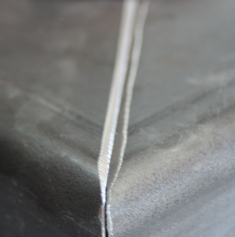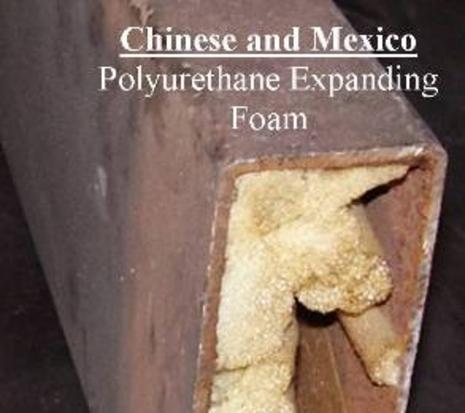We take great pride in handcrafting these American made iron products. We use only U.S. produced steel and materials. Each unit is hand made, even the finish is applied by hand. We encourage you to compare our decorative iron entry doors with any other on the market. Click the links to the right to see first hand comparisons, or scroll down the page for more information on the highest quality American made decorative iron doors on the market.
Specifications and Comparison
Next, locking the components together on our steel assembly tables, each piece is “dry fit” into place by hand. This gives our artisans the opportunity to fine tune the connections hand grinding and fitting each individual component of your unit. Each connection is then welded using inert gas assisted MIG weld joints.
The process begins with preparing the 2 X 6 X 1/8” wall steel tube (same material used to produce car and truck frames) for the styles, rails, and jamb lengths. All connection points are mitered and prepped with chamfered weld surfaces for optimum strength and rigidity. Using 1/8” thick wall tube gives us this opportunity while other similar products use a simple flat weld joint. The chamfer gives the weld more surface area even after grinding and polishing to create a solid weld joint.
Components
1/8"(11GA) wall 2X6 Tube
1/8"(11GA) wall 2X6 Tube
*1/2" - 3/4" solid hand forged bar
*6" - 8" bushed w/ turned finials
Black/Bronze Aluminum w/ composite insert
Jamb
Door Style/Rail
Scroll
Hinges
Thresh
* Determined by design
After the rough grind, the process of hand forging your iron scroll begins. This process is the bulk of the time spent producing your product. We pride ourselves in the craftsmanship of our iron scroll. This stage of the process begins with the iron square or round bar (size of bar dictated by your design preference) cut to the correct lengths to produce the scroll components for your unit. Using the cut lengths, we hand forge the end tapers and end curl. Bending the scroll we slowly heat the bar locked into our “scrolling dies” (see photo left). We also hand forge our own dies produced by our artisans. The discoloration shown in the photos are caused by the heating process this will be removed in later steps. Once all your scroll and design components are created, we begin the scroll dry-fit.
Dry fitting the scroll components in your unit is very important. We achieve this by hand fitting each piece directly into your unit. Each is shaped and carefully placed to the final position. Once fitted, connection by welding each point where the scrolls intersect or touch is performed. This part of the scrolling process creates one scroll unit out of all the scrolled components. Finally, the scroll unit is attached welding each connection point to the door panel.
Once the scroll is in place it’s time to assemble the jambs to the door panels. Welding the hinges from the door panel to the jamb, we calculate our tolerances at the margins very close for optimum seal to weather strip. The jamb is equipped with a groove continuously around to receive compression weather stripping.
Door construction is only as good as the hardware you use. Our 3/4” X 6” or the 1 3/16” X 8” steel turned finial tip hinges are rated to operate over 800 lb each. We use a bushing style hinge which will out perform and out last those greasy barrel hinges. We dress even our hinge welds for detail.
The window latches are solid cast iron pivot pull latches verses the simple cast aluminum catches used by other door companies giving our doors higher performance and strength.
We offer both fixed and operable glass panels. Our operative panels feature our elegant window latches and 3” barrel hinges. This allows for easy glass cleaning, while also keeping you and your family safe when answering the door having solid forged iron between you and the outside. Security is piece of mind.
Fixed glass panels help with budget while not loosing the same look and feel as the operable panels. Ask your sales representative for more info.
We use 1/2 clear insulated glass as default, but upgrades to Glacier, Rain, or Low E glass are available. Ask your sales representative for more info.
Hinges
Window latches
Polyurethane or known as expanding foam is used in most all imported decorative iron doors. This type of foam has several drawbacks in both the short and long term. Polyurethane foam expands quickest at the openings closing air flow to the rest of the tube, air is needed in order to expand properly and cure. As in the case of this photo (far right) you can see that the foam did not fully expand and a large void in the insulation has formed due to the lack of air flow.
American Iron Doors uses an accustical insulation which is installed during the fabrication process to insure the entire tube is filled to capacity. This eliminates voids in the insulation giving our door panels an R-9 insulation value.
A far worse problem with Polyurethane expanding foam is that it is an "open cell" foam. This means that each tiny bubble in the structure of the foam is open at least on one side to the other bubbles touching. This causes wicking which leads to other serious structural and health hazards. In the photo (right) you can see a badly rusted jamb on the interior where the Polyurethane expanding foam wicked and held water. This also led to the growth of mold in the wet foam itself.
Accustical Insulation: is a far better product,
it has a fire rating of 1200 degrees F.
It also offers a sound deading quality, that polyurethane or polyestyrene cant match.
Which would you prefer in your Iron Door?
An imported door less than a year installed
The disadvantages of the open cell polyurethane expanding foam is evident in this photo (left). The jamb has seriously rusted as the open cells have wicked water and held it against the steel while mold is present in the wet foam itself.
American Iron uses only domestic U.S. 11 gauge steel in the construction of our iron entry doors from the door panels to the jamb.
As you can see in the photo (right), our steel is a full 1/8" (11GA) wall thickness while the imported door (far right) is 4 hundredths thinner around 14 gauge. The differences don't stop there.
Our U.S. steel is considered "mild steel" as defined by the AISI, having a higher carbon content then that of the imported steel. Higher carbon translates into strength and higher resistance to corrosion.
American Iron
U.S. 11 gauge steel
Imported door
14 gauge steel
Insulation Comparison
Steel Comparison
The components of any door directly effect the quality of the door, i.e. cheap parts low quality. For this reason American Iron uses 8" turned finial tip steel bushed hinges (right) rather than the lessor 4" to 5" grease barrel hinges (far right). Bushed hinges require less maintenance and are much more durable over time. Each of our hinges are rated to operate 1000 lbs per hinge. Our hinges are produced here in the U.S. and you won't find them on any other iron door. These are our signature hinge.
Hinge Comparison
American Iron
8" turned finial tip bushed hinges
Imported door
Grease barrel hinge
Another great example of higher American Iron quality can be found in the operative glass panel latches featured on all of our doors. These beautiful decorative latches are far more than elegant, they are also rigid and durable cast iron. This in comparison with the simple thumb latch used in imported doors made from aluminum. This also gives an American Iron door a stronger connection at the window latch as well. Also notice the difference in the L brackets that the latches catch. American Iron uses a solid 1/2" round steel L instead of a sheetmetal bracket.
Hardware Comparison
American Iron
Cast iron window latches
Imported door
Cast aluminum thumb latch
American Iron
Decorative Scroll
Imported door
Tapered Scroll
Also notable is the difference between plain tapered scroll and true hand forged decorative iron scroll. American Iron uses drop forged fishtail and spiral finial tip scroll in our scroll designs. Attention to details in the scroll design separates our entries true craftsmanship from mass-produced imported doors.
The decorative finial tip scroll gives an American Iron entry a softer, more authentic feel, no one else offers this iron architectural detail.
Scroll Comparison
Our designs are created and fitted to each American Iron entry making no two doors exactly alike. Most of our Concept Designs have never actually been produced, but are used as a base design to help create your custom scroll. The process is easy, and you can participate in the creation of your decorative iron door.
Using solid square and/or round steel bar depending on the design; the iron is inviting yet extremely durable and rigid. Answering your door using the operative glass panels gives you and your family more protection and security.
The difference between true decorative hand forged scroll and simple tapered scroll is easy to see. Only American Iron offers this rare authentic iron detail.
Fabrication Process
Located:
2425 Helen Hwy Cleveland, GA 30528
Copyright 2010 American Iron: Atlanta Iron Doors. All Rights Reserved.
800-322-4125
Call Toll Free:






